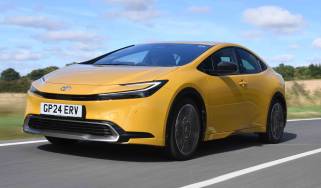Toyota to launch hydrogen fuel cell vehicle in 2015
Toyota's future fuel cell technology to be showcased at the Frankfurt motor show 2013
Toyota has revealed more details about its first hydrogen fuel cell vehicle, which it says will go on sale by 2015.
It has now confirmed that an updated version of the fuel cell technology first shown in the FCV-R concept (from the 2011 Tokyo show) will be revealed in Frankfurt. The powertrain is similar to the hybrid system found in the Toyota Prius. However, a hydrogen fuel cell replaces the engine, while high-pressure hydrogen tanks replace the conventional fuel tank.
Toyota has managed to halve the size of the fuel cell stack, while doubling the power density to 3.0kW per litre. This makes for increased practicality and a reduction in cost as the whole hydrogen fuel cell system can be located beneath the floor. That also means there's no intrusion on interior or load space.
Toyota claims that during tests the FCV-R concept achieved a maximum driving range of 420 miles. In the real world, however, a range of more than 300 miles is likely, with the only waste product being water vapour.
Hydrogen powered vehicles have always been a very attractive prospect for manufacturers as, in theory, they provide emissions-free motoring and relatively low running costs. A price-tag of less than £70,000 has been claimed "attainable" by Toyota for its FCV-R saloon but that clearly needs to fall even further before hydrogen vehicles become truly mass market.
Toyota is predicating FCHVs will be available globally during the 2020s, supported by a wider roll-out of hydrogen refuelling stations. Yet, Toyota still plans to introduce an affordable FCHV saloon in Japan, North America and Europe by 2015.
Toyota's advancements in alternatively fuelled vehicles don’t end there. The next generation Toyota Prius will be fitted with a more efficient and powerful hybrid system meaning reduced emissions as well as costs. The newly developed powertrain will also be fitted to a wide range of Toyota and Lexus models in the future.
Find a car with the experts







